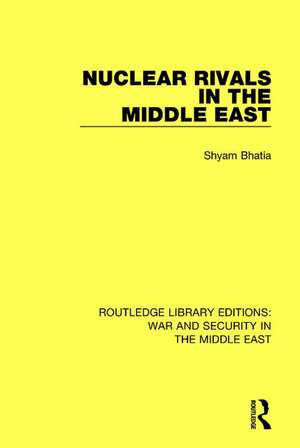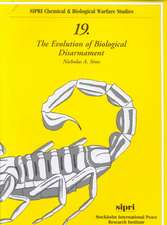Nuclear Rivals in the Middle East: Routledge Library Editions: War and Security in the Middle East
Autor Shyam Bhatiaen Limba Engleză Paperback – 2 oct 2017
| Toate formatele și edițiile | Preț | Express |
|---|---|---|
| Paperback (1) | 344.90 lei 6-8 săpt. | |
| Taylor & Francis – 2 oct 2017 | 344.90 lei 6-8 săpt. | |
| Hardback (1) | 625.03 lei 6-8 săpt. | |
| Taylor & Francis – 11 iul 2016 | 625.03 lei 6-8 săpt. |
Preț: 344.90 lei
Nou
Puncte Express: 517
Preț estimativ în valută:
65.99€ • 68.91$ • 54.50£
65.99€ • 68.91$ • 54.50£
Carte tipărită la comandă
Livrare economică 15-29 aprilie
Preluare comenzi: 021 569.72.76
Specificații
ISBN-13: 9781138655430
ISBN-10: 1138655430
Pagini: 130
Dimensiuni: 156 x 234 x 7 mm
Greutate: 0.18 kg
Ediția:1
Editura: Taylor & Francis
Colecția Routledge
Seria Routledge Library Editions: War and Security in the Middle East
Locul publicării:Oxford, United Kingdom
ISBN-10: 1138655430
Pagini: 130
Dimensiuni: 156 x 234 x 7 mm
Greutate: 0.18 kg
Ediția:1
Editura: Taylor & Francis
Colecția Routledge
Seria Routledge Library Editions: War and Security in the Middle East
Locul publicării:Oxford, United Kingdom
Public țintă
Postgraduate and UndergraduateCuprins
1. Nuclear Proliferation: the Framework of Risk 2. The Nuclear Fuel Cycle 3. Israel 4. Egypt 5. Libya 6. Iraq 7. Iran 8. Pakistan 9. Conclusion
Descriere
Nuclear weapons are the elusive ‘toys’ of modern warfare and are hankered after by every Middle Eastern government. Although no Middle eastern government has formally admitted that the purpose of its investment in nuclear research is to develop weapons, it is certain that two countries, Israel and Pakistan, have mastered the technology for making nuclear bombs and that others are attempting to manipulate their nuclear hardware to this end. The combination of these nuclear ambitions, the large amounts of money that can be made available for research and the area’s political instability make the region a powerful example of both the drive towards, and the dangers of, nuclear proliferation. This book, first published in 1988, examines the evolution of nuclear research and development in the region. It shows that it is the product of a complex web of internal and external factors, fuelled by considerations of international prestige and local rivalries. Whilst concluding that it is probably no longer possible to prevent the spread of nuclear weapons technology to the Middle East, it suggests ways in which the rate of proliferation can be slowed down.


























